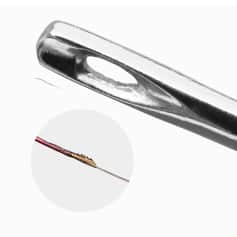Micro Laser Welding
Achieving manufacturing goals using micro-welding for extremely small fusion zones of very thin materials
What is micro-welding and how can it help my company? Micro-welding is a set of technologies used to perform welding on thin or delicate materials with a fusion zone dimension of less than 100 microns. It is also known as point or dot welding. In general terms, it refers to precision welding with narrow tolerances and very high temperatures.
How does micro-welding work?
How does micro-welding work? The welded metal is deposited in small dots using a minimal amount of heat in a tightly controlled environment. The welding process is designed not to interfere with product function and quality. Most micro-welding operations are performed under a microscope at 20x-40x magnification using miniature tools to precisely place the hardware elements and filler metal, if required, in the correct location.
The following welding technologies have been successfully applied to micro-welding:
- Electron beam
- Resistance
- Flash
- Arc (tig, mig and plasma)
- Laser
Applications of micro-welding include medical implants, dental appliances, batteries, thermocouples, sensing devices, and other uses. Dot welding is used for connecting very small materials and materials made from different substances. For example, dot welding is used for welding steel to copper, where both substances are measured in tenths of a millimeter. Traditional welding or soldering methods are not suitable for joining copper and steel in such cases. Laser welding is required for this type of weld. In laser dot welding, very thin threads of a tenth of a millimeter are overlapped and welded with an extremely precise laser
Applications of laser micro-welding in the medical industry
One example is connecting non-copper-based coils of a heater. Copper cannot be used as a heating element because it will melt. Steel is used instead. However, to conduct electricity across a long distance, the steel must be connected to a copper wire. This connection is achieved using laser welding.
In another example, the goal is to connect a 10-micron copper thread to a 40-micron copper thread. Although it is theoretically possible using tin, at least half of the welds would fail, resulting in ruined wires.
Introducing thermo-pressure bonding
At Benatav, we have developed a welding process using pressure and heat that does not require tin. Tin introduces dirt and flux to the process. We use only pressure and heat to weld the two copper wires together at the molecular level. The result is a very stable, robust connection.
This innovative technology, developed by Benatav, is known as thermo-pressure bonding. The technique has been thoroughly tested in a wide variety of customer environments. In addition, thermo-pressure bonding has been integrated into mass production processes and meets the standards required for medical applications.
Thermo-pressure bonding can connect ultra-fine wires to other ultra-fine wires, to terminals or PCBs. Other examples include:
- Copper to copper connection of micro-coils to PCBs, using a mediating thicker wire
- Connecting micro-coils to a support system using a gold-plated terminal
- Miniature thermocouples based on connecting copper to constantan using ultra-fine wires
Can micro-welding help your company?
What can micro-welding do for you? Benatav is ready to help you with any questions or concerns you may have regarding the use of micro-welding in your manufacturing process. To contact us, please phone +972-3-9345951 or email info@benatav.com.



